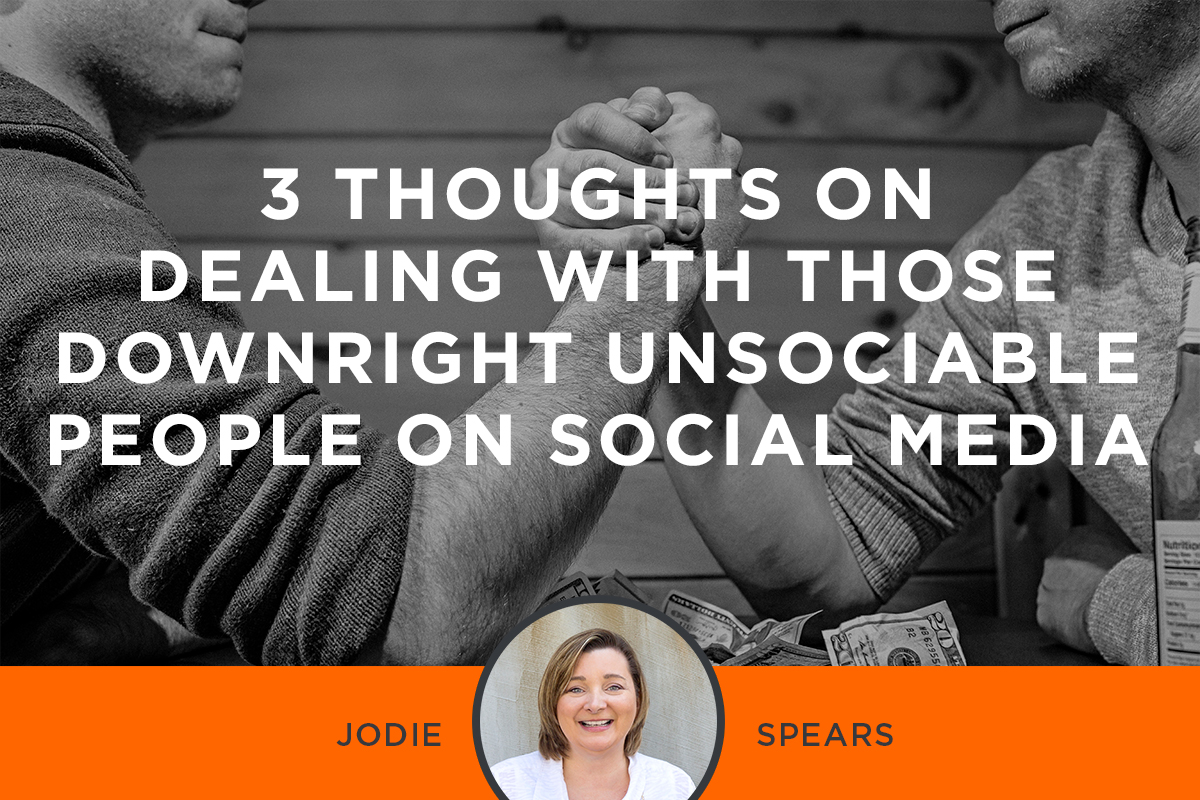My mom had a saying.
“Thoughts that shouldn’t be said should remain in your head.”
Being polite is one of the first lessons we learn growing up. So what’s happened to polite conversation in the era of social media? At a time when we can connect with so many people so easily, why are a few folks doing their best to make people want to stay away?
As an individual, you can un-friend that guy from high school who was a riot in third-period English but has some pretty unsavory political views today. But if you manage a brand on social media, things are a little more complicated.
Here are my 3 Thoughts on Dealing with Those Downright Unsociable People on Social Media. (I don’t call these RULES, because you can’t establish rules for a game that is always changing. And, in social media, the channels, algorithms, reach, audience, etc. are always changing.)
As an individual, you can un-friend that guy from high school who was a riot in third-period english but has some pretty unsavory political views today. But if you manage a brand on social media, things are a little more complicated.
THOUGHT 1: Don’t Be Surprised When Things Take a Negative Turn
No matter how positive, wonderful or absolutely life affirming your post, video, tweet, or blog is, you’ll likely encounter a negative response or two. Not always … but be prepared.
I once worked on a campaign gathering donations of diapers for babies in need. A charitable campaign to help babies … little bitty, adorable babies. We used social media to announce drop-off locations, plug upcoming TV interviews and take photos of incredibly generous people dropping off diapers. How could that possibly generate negative Facebook posts?
Turns out there were plenty of people who took issue with our diaper drive. Environmentalists condemned us for not promoting cloth diapers. Some took issue with the parents who “shouldn’t have babies they can’t afford.” And others simply didn’t like the drop-off locations we chose. To be honest, at the time I was very surprised at the negativity. Lesson learned.
THOUGHT 2: Not All Negative Responses Are Equal
There are varying degrees of negativity on social media. You have your Eeyore types whose posts are full of cynicism, negativity and an unusually high number of typos but, for the most part, they are harmless.
Watch out for those filled with anger, violence, threats, racism, sexism (all “isms”, really), or anything listed in the warning prior to a TV show that “is intended for mature audiences, viewer discretion advised.” These should be deleted immediately and a message sent to your followers that certain behaviors are unacceptable. You can also message the perpetrator to explain why the message was deleted and ask that they refrain from similar posts.
While social media is a public space, you are the moderator of your own conversations. You owe it to the people who like, follow or friend you to keep this kind of thing away. Establish a policy about language or messages that are not acceptable and stick with that.
THOUGHT 3: Sometimes you respond; sometimes you don’t.
For those posts that aren’t harsh enough to warrant an all out delete, but are still problematic, you have to consider how or if you will respond.
During the diaper drive, we responded to the environmentalists in a positive way, encouraging them to drop off cloth diapers at our donation site. (Not a single cloth diaper was dropped off, by the way.)
We also took the opportunity to tell the story of diaper need. Many of the people who needed our help had to send their children to daycare centers that would not accept children in non-disposable diapers or lacked access to a washing machine at home. During media interviews, we addressed the issue as well. Turned out those negative posts helped us find a new story to tell.
For people who posted hateful things directed at those “irresponsible” parents, the online community actually responded for us. Some people talked about their own situations — dealing with the aftermath of a tornado and not having access to clean diapers or needing help during a few tough months. Again, we found new stories to tell online and through traditional broadcast channels. We thanked each person for posting his/her story and continued to stay on message. Eventually the trolls gave up.
Don’t rush to post a response. Wait to see how the online community responds. The people who support your cause, brand or message will likely help re-focus the conversation. The result might be far better and more impactful than posting a million talking points.
Monitor closely. Stay on message. Correct facts when necessary. And trust the online community to put the social back into social media.


